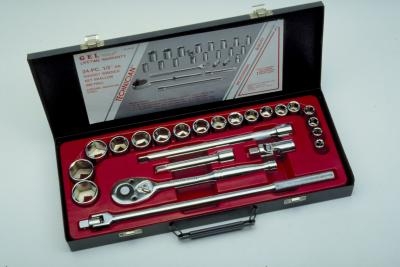
The ball joint on your 1996 Dodge Ram 1500 truck connects the steering knuckle to the control arm and pivots to allow for suspension travel and steering input. If one of the two ball joints on either side of the truck goes out, you will experience abnormal tire wear and the truck may at times weave somewhat while you're driving.
Park the truck on a firm and level surface. Set the parking brake. Loosen the lug nuts by turning them counterclockwise with the lug wrench.
Place the jack under the frame just behind the wheel you're going to work on and lift the truck until the front wheel is off the ground. Place the stand under the frame just behind the jack and carefully lower the truck onto the stand. Finish removing the front wheel.
Remove the caliper retaining bolts by turning them counterclockwise with the ratchet. Hang the caliper from the upper control arm with a piece of wire hanger. Pull the dust cover off the hub with the large slip joint pliers. Straighten the cotter pin and remove it with the wire cutters. Remove the lock cover by pulling it off and place it in the dust cap. Loosen the center hub nut by turning it counterclockwise with the large pliers and place it in the dust cap. Pull the rotor assembly off the spindle and set it aside.
Remove the front shock absorber by turning the top retaining nut and the lower bolts counterclockwise with the ratchet and socket. Insert the spring compressor tool into the middle of the coil spring and clamp the top and bottom coils. Take up the tension on the coil by turning the center bolt on the compressor clockwise. Back off the compressor one half turn.
Straighten the cotter pin and remove it by pulling it out with the wire cutters. Remove the ball stud nut by turning it counterclockwise with a wrench. Insert the pickle fork between the steering knuckle and lower control arm and strike it sharply with the hammer until the ball joint separates from the knuckle. Pull the coil spring and rubber isolator out.
Install the ball joint press so as to press the ball joint out of the lower control arm. The ball joint will need to be pressed downward. Turn the threaded stud clockwise with the wrench to press the ball joint out. Turn the threaded stud counterclockwise to loosen the tool and remove the old ball joint. Insert the new ball joint and turn the tool around to press the ball joint in. Turn the threaded stud clockwise with the wrench to press the ball joint into the lower control arm. Place the rubber boot over the ball joint. Lift the coil spring into place and replace the rubber isolator on the lower control arm.
Turn the threaded stud counterclockwise to loosen the ball joint press and remove it. Turn the ball stud so it faces front to rear. Insert the ball stud into the hole in the steering knuckle and thread the nut onto the stud by turning it clockwise by hand. Tighten the ball stud retaining nut to 135 foot-pounds if 11/16 or 175 foot-pounds if 3/4. If the holes in the nut and ball stud don't line up, tighten the nut until they do. Insert the cotter pin through the holes and bend it over the stud to secure it.
Remove the spring compressor tool by turning the threaded stud counterclockwise and remove it. Insert the shock absorber from the bottom, making sure the rubber and metal grommets are in place on the shock rod. Replace the upper grommets and thread the nut onto the shock rod by turning it clockwise by hand. Tighten this nut to 25 foot-pounds with a torque wrench. Thread the bottom retaining bolts in by hand, turning them clockwise and tighten them to 200 inch-pounds.
Slide the rotor over the spindle, insert the bearing, tapered end first, then the large, keyed washer. Thread the lock nut onto the spindle by turning it clockwise by hand. Tighten it to approximately 15 foot-pounds by turning it with either a socket or the large pliers. Slide the castle lock over the spindle nut and insert the cotter pin through the hole and bend it over the spindle to secure it.
Slide the caliper over the rotor and insert the retaining nuts. Thread them into the holes by turning them clockwise by hand. Tighten these bolts to 2 foot-pounds.
Replace the wheel and threads the lug nuts onto the studs by turning them clockwise by hand.
Lift the truck off the jack stand and remove the stand. Lower the truck until the wheel makes contact on the ground. Tighten the lug nuts in a star pattern to 135 foot-pounds. Lower the truck and pull the jack and wheel chocks out.